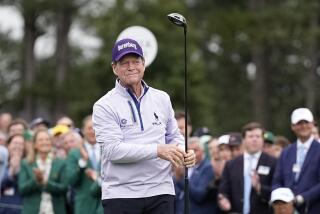Callaway Golf charting a course out of the rough

After a long time in the rough, Callaway Golf Co. may be back on the putting green.
The Carlsbad, Calif., maker of golf clubs, golf balls and related accessories recently reported strong first-quarter results, but Callaway Chief Executive Oliver G. “Chip” Brewer III knows there is more convincing to do among current and potential investors.
Brewer, 50, recently told a group of investors that Callaway “is clearly a historical brand. It’s been a leader in the business, and yet, at this point, it is a turnaround story.”
Callaway has long been a giant in the golf industry. It’s a global brand, with 52% of its sales overseas, mostly in Japan and Europe. Some of the most successful pros swear by its golf clubs, including 42-time PGA Tour event winner Phil Mickelson.
Another Callaway user, Colin Montgomerie, just won the Senior PGA Tournament.
Callaway was founded in 1982 by golf visionary Ely Callaway. It went public in 1992. But the company hooked its business plan sharply into the rough in the early 2000s, Brewer said.
Callaway, Brewer said, turned to acquisitions for growth rather than the innovation that had driven the company’s earliest years. The company bought the Top Flight, Ben Hogan and Strata brands in 2003. It also added footwear and apparel.
“These were not necessarily strategic mistakes,” Brewer said, “but they never bore fruit.”
And when the global recession hit, Brewer said, “the company was vulnerable.”
Red ink and layoffs ensued. In 2012, Brewer and a new management team were brought on to make major changes.
Top Flight and Ben Hogan were sold. The company also licensed its apparel brand to Perry Ellis International and still receives income from that deal.
“Before anything else we have to be the world’s best at premium total performance golf equipment and balls. First and foremost,” Brewer said.
The latest
In spite of such challenges, Callaway seems to have improved its swing in 2014.
First-quarter sales climbed to $351.9 million, up from $287.8 million a year earlier. Company net income rose to $55.3 million, up from $41.7 million.
Accomplishments
Brewer said that one of Callaway’s smartest moves came in February when it brought back the Big Bertha driver, a club made famous by Ely Callaway’s salesmanship.
The company continues to take advantage of its veteran tour players. It recently began a promotion offering anyone who tries out a Big Bertha the chance to win the same amount of money that Mickelson earns (up to $1.5 million) at the U.S. Open this month.
But Callaway has also reached out to younger players to appeal to the important 18-to-34 age group. Pro Callaway golfers now include Ryo Ishikawa, who is 22; Patrick Reed, 23; and Gary Woodland, 30.
Challenges
According to the National Golf Foundation, only 14 new golf courses were built in 2013 while 157 were closed. The number of golf courses has declined eight straight years, the foundation said. The 15- to 34-year-old age group has shown some of the biggest declines in players, according to Pellucid Corp., a business research group.
Many of today’s parents seem more inclined to spend their free time ferrying children back and forth to their events rather than on a round of golf. Gains in women players had been dwarfed by losses among men.
And it’s an expensive sport. Even at the low end, a full set of clubs costs about $300. A single Big Bertha Alpha driver costs $500.
Pellucid estimated there were 25.7 million players in 2013, down from a peak of 29.8 million in 2000-01.
Analysts
Of nine analysts that follow Callaway Golf, four rate it a strong buy and three consider it a buy. Two say to hold the stock.
“The new Big Bertha clubs have been very well received,” said Lee J. Giordano of CRT Capital. “The Callaway brand is regaining traction in the golfing community.”
Twitter: @RonDWhite







